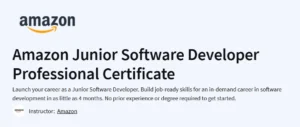What will you learn in A Complete Guide to Java Programming Course
Understand Java’s core paradigms—object-oriented and procedural programming—and how they map to real-world applications
Work fluently with Java fundamentals: objects, data types, variables, arrays, and control structures
Master iterative constructs, algorithms, and data structures through hands-on coding challenges
Apply exception handling and use Java’s rich I/O and collection frameworks for robust programs
Set up your Java development environment—JDK, IntelliJ IDEA, and Apache Commons Lang—for professional workflow
Program Overview
Module 1: Java, a High Level Language with a Purpose
⏳ 26 minutes
Topics: What makes Java high-level; memory management (heap vs. stack) and application benefits
Hands-on: Quiz Yourself on Java Basics and explore memory allocation exercises
Module 2: How Java Programming Works
⏳ 15 minutes
Topics: Procedural vs. OOP paradigms; Java class structure and program entry points
Hands-on: POP vs. OOP quiz and “Java Program is Written Within a Class” exercise
Module 3: Objects and Data Types
⏳ 46 minutes
Topics: Object characteristics, primitive vs. reference types, and naming conventions
Hands-on: Variable declaration and compute-sum challenges with solution reviews
Module 4: Variables: The Name of a Field
⏳ 41 minutes
Topics: Field vs. local variables, scope rules, and access modifiers in Java
Hands-on: Declare class attributes, explore reference vs. local variables exercises
Module 5: Arrays: The Container Objects
⏳ 51 minutes
Topics: Declaring, initializing, and manipulating arrays; using Apache Commons Lang helpers
Hands-on: Compute sum-of-array challenge and review sample solutions
Module 6: Operators and Conditional Statements
⏳ 41 minutes
Topics: Arithmetic, relational, instance-of, and conditional operators; control flow constructs
Hands-on: Decimal-to-binary conversion challenge with solution walkthrough
Module 7: Iterative Constructs, Entry and Exit Controlled Loops
⏳ 31 minutes
Topics: ‘for’, ‘while’, and do-while loops; fixed vs. unfixed iteration patterns
Hands-on: Loop examples exercises and quiz on iterative constructs
Module 8: Algorithms
⏳ 56 minutes
Topics: Introduction to algorithms; solving Fibonacci, reversal, and numeric-sum problems
Hands-on: Multiple algorithmic challenges (Fibonacci sum, reverse number, odd-negative sums)
Module 9: Basic Input and Output
⏳ 10 minutes
Topics: Using
Scannerfor console I/O and best practicesHands-on: Input/output quiz based on real-world scenarios
Module 10: Classes and Objects
⏳ 26 minutes
Topics: Defining classes, object instantiation, and polymorphism basics
Hands-on: Classes-and-objects quiz with examples
Module 11: Interface and Abstraction
⏳ 10 minutes
Topics: Designing abstractions and implementing interfaces for flexible code
Hands-on: Interfaces and abstraction quiz
Module 12: Exception Handling and Data Structures
⏳ 15 minutes
Topics: Try/catch constructs and an overview of Java’s data structures
Hands-on: Exception-handling quiz
Module 13: Conclusion
⏳ 5 minutes
Topics: Continuous practice strategies and navigating Java documentation
Hands-on: Wrapping-up reflection exercise
Module 14: Appendix
⏳ 15 minutes
Topics: Installing JDK, IntelliJ IDEA setup, and integrating Apache Commons Lang
Hands-on: Environment setup tasks and configuration checks
Get certificate
Job Outlook
Java Developers earn an average base salary of $136,284 USD per year in the U.S.
Employment of software developers is projected to grow 21% through 2030, driven by enterprise, mobile, and cloud applications
Skills in Java, algorithms, and data structures open roles in finance, e-commerce, and large-scale backend systems
Proficiency in Java development tools and best practices boosts prospects for senior engineering and architecture positions
Explore More Learning Paths
Master the art of Java programming and take your coding skills from beginner to professional. These related courses will guide you through object-oriented programming, real-world projects, and advanced Java concepts for modern software development.
Related Courses
Object-Oriented Programming in Java Course — Deepen your understanding of Java’s object-oriented principles and learn to write cleaner, modular, and reusable code.
Java Programming for Complete Beginners 2025 Course — Start your Java journey with beginner-friendly lessons that build a solid foundation for web, app, and enterprise development.
Java Programming and Software Engineering Fundamentals Specialization Course — Explore core programming concepts, software design, and data structures to prepare for a successful tech career.
Related Reading
What Is Program Management? — Learn how structured planning and execution — similar to writing efficient Java programs — drive success in complex technical projects.
Specification: A Complete Guide to Java Programming Course
|





